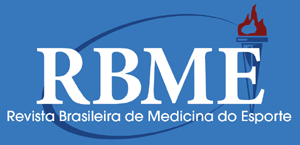Resumo em Português:
Padrões adequados de força muscular e flexibilidade permitem movimentação eficiente, melhorando a performance desportiva e conferindo qualidade de vida. Entretanto, não se conhece a potencial interferência mútua entre força e mobilidade articular. O objetivo deste estudo foi investigar a relação entre força muscular e flexibilidade global e segmentar em adultos jovens. Cinqüenta (30h; 20m; idade 22 ± 4 anos) indivíduos sadios foram submetidos a avaliação cineantropométrica (peso corporal, altura, circunferências, dobras cutâneas), de mobilidade articular máxima passiva (método Flexiteste, que compara a amplitude atingida com mapas de referência) e de força muscular esquelética máxima [método de uma repetição máxima (1RM) de handgrip, legpress e supino horizontal]. Os resultados de força muscular foram corrigidos pela circunferência muscular correspondente, calculada como circunferência do membro subtraída da dobra cutânea vezes valor de π. A flexibilidade global (flexíndice = somatório dos resultados dos 20 movimentos articulares) foi maior nas mulheres [(mediana e amplitude) = 52 (3869)] em relação aos homens [46 (37-57); p = 0,004] à custa de maior flexibilidade segmentar (somatório dos resultados de movimentos relacionados) de quadril (p = 0,004), coluna (p = 0,006) e membros inferiores (p = 0,011), enquanto a força muscular global e por movimentos foi superior nos ho-mens (p = 0,001). Não existiu correlação entre flexibilidade e força muscular para mulheres ou homens, seja do ponto de vista global (mulheres: r = 0,149; p = 0,531; homens: r = 0,092; p = 0,628) ou segmentar (p > 0,05). Concluímos que, considerando a faixa etária estudada, as mulheres têm maior flexibilidade, principalmente nos movimentos de coluna, quadril e membros inferiores, enquanto os homens apresentam maior força muscular global e segmentar, mesmo corrigindo-se a diferença de massa muscular. Os resultados sugerem que não existe relação entre força muscular e flexibilidade em adultos jovens sadios.
Resumo em Inglês:
Adequate levels of muscle strength and flexibility allow for efficient movements, improving sports performance and providing a better quality of life. However, the potential mutual interference between strength and joint motion is unknown. The purpose of the study was to investigate the relationship between global and regional muscle strength and flexibility in young adults. Fifty (30 men, 20 women, age 22 ± 4 years) healthy subjects were submitted to an evaluation consisting of kineanthropometry (body weight, height, limb girths, skinfolds), measurement of the maximal passive range of joint motion (flexitest method which compares the joint range achieved to reference maps) and of the peak skeletal muscle strength [one-repetition maximum (1-MR) test of hand-grip, legpress and bench press]. The results of muscle strength were corrected by the corresponding muscular girth, calculated by subtracting the limb girth from the skinfold times the π value. The global flexibility (the sum of the result of all 20 joint movements) was higher in women [(median and range) = 52 (38-69)] compared to men [46 (37-57); p = 0.004] due to a higher regional flexibility (the sum of related movements) of the hip (p = 0.004), spine (p = 0.006) and lower limbs (p = 0.011), whereas the strength of each movement was higher in men (p = 0.001). There was no correlation between flexibility and muscle strength either for men or women, when all data points were pooled (women: r = 0.149; p = 0.531; men: r = 0.092; p = 0.628) or separated by body regions (p > 0.05). The authors concluded that, considering the age range studied, women presented higher flexibility than men, particularly for the movements of the spine, hip and lower limbs, while men present higher global and regional muscle strength, even when corrected for the difference in muscle mass. Results suggest that there was no relationship between muscle strength and flexibility in healthy young adults.
